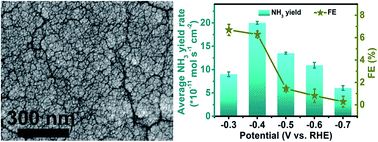A magnetron sputtered Mo3Si thin film: an efficient electrocatalyst for N2 reduction under ambient conditions†
Abstract
Industrially, large-scale NH3 production mainly depends on the Haber–Bosch process, which is accompanied by heavy greenhouse gas emission and serious energy consumption. Electrochemical N2 reduction is considered a sustainable strategy to solve this problem. Herein, we report for the first time that a Mo3Si thin film sputtered on graphite paper is a favorable electrocatalyst for NH3 synthesis under ambient conditions. Electrochemical tests suggest a large NH3 yield rate of 2 × 10−10 mol s−1 cm−2 and a high Faraday efficiency of 6.69% at −0.4 V and −0.3 V vs. a reversible hydrogen electrode, respectively, in 0.1 M Na2SO4. It also demonstrates the high electrochemical and structural stability of such a catalyst as well as excellent selectivity for NH3 generation. Density functional theory calculation reveals that the synergy of the metallic conductivity of Mo3Si and the high chemical activity of the exposed Mo ions benefits the adsorption and activation of N2, and a further proton–electron transfer reaction to produce NH3.

- This article is part of the themed collections: Editor’s Choice 2023: Advancing electrocatalysts for a sustainable future., Energy Frontiers: Electrochemistry and Electrochemical Engineering, Journal of Materials Chemistry A Lunar New Year collection 2022 and 2021 Journal of Materials Chemistry A most popular articles


 Please wait while we load your content...
Please wait while we load your content...